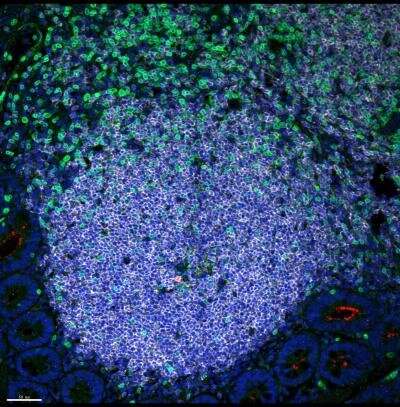
In a groundbreaking study, a team of UC Davis researchers has discovered a special type of stem cell that can reduce the amount of the virus causing AIDS, boosting the body’s antiviral immunity and repairing and restoring the gut’s lymphoid follicles damaged by the simian immunodeficiency virus (SIV), the equivalent of the human immunodeficiency virus (HIV) in non-human primates.
The study, published June 22 in JCI Insight, showed the mechanism through which mesenchymal stem/stromal cells (MSCs) enhance the body’s immune response to the virus. It also provides a roadmap for developing multi-pronged HIV eradication strategies.
“Impaired immune functions in HIV infection and incomplete immune recovery pose obstacles for eradicating HIV,” said Satya Dandekar, senior author of this paper. “Our objective was to develop strategies to boost immunity against the virus and empower the host immune system to eradicate the virus. We sought to repair, regenerate and restore the lymphoid follicles that are damaged by the viral infection.”
The lymphoid tissue in the gut is an early site for viral replication and the establishment of viral reservoirs. Dandekar’s group has previously shown that an HIV infection causes severe loss of gut mucosal T immune cells and disrupts the gut epithelial barrier lining, leading to a leaky gut.
“The lymphoid follicles are organized structures where the long-term immune attack is launched against pathogens by generating antibody response targeting the virus. These important regions are functionally impaired very early following HIV infection,” Dandekar said.
While antiretroviral drugs effectively suppress viral replication, they do not repair the damage caused by the virus to the immune system. On their own, these drugs cannot restore the functionality of the lymphoid follicles damaged by HIV infection.
Can stem cells counteract the gut damage caused by HIV?
The researchers administered bone marrow-derived MSC in a rhesus macaque model of AIDS that had impaired immunity and disrupted gut functions due to the viral infection.
“We are starting to recognize the great potential of these stem cells in the context of infectious diseases. We have yet to discover how these stem cells can impact chronic viral infections such as AIDS,” Dandekar said. She is a professor at and the chairperson of the Department of Medical Microbiology and Immunology at UC Davis and affiliated with the California National Primate Research Center.
The study found that the MSCs can modulate, alter and remodel the damaged mucosal site. There were immediate benefits, with a rapid rise in antibodies and T-immune cells targeting the virus. The stem cells were instrumental in the recovery and restoration of these lymphoid follicles.
MSCs also offer an opportunity for an innovative, multi-pronged HIV cure strategy by complementing current HIV treatments.
“Stem cells are good synergistic partner components with drugs. The antiretroviral drugs can stop the fire of the viral infection but cannot restore the forest of the lymphoid tissue compartment. The MSCs would rejuvenate the field and bring back immune vitality,” Dandekar said.
Even without the use of antiviral drugs, MSCs were able to increase the host’s antiviral response by repairing the lymphoid follicles, restoring the mucosal immunity and reviving what has been targeted by the virus very early on.
MSC treatments
MSC treatments require well defined cell quality controls and specific delivery mechanisms. The UC Davis Stem Cell Program, a center for excellence for stem cell research, is leading multiple clinical trials on MSC use in treating diseases such as spina bifida and Huntington’s disease. Findings from this study provide a scientific basis for investigating MSC in treating HIV and other infectious diseases in the clinical setting.

